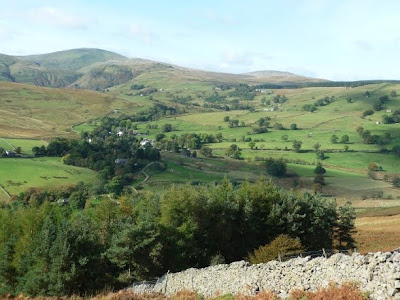Our hoped-for quiet night at Skelwith Fold was interrupted, quite early, by an all-night/all morning gale—make that, now, all-day gale—30-40 mph winds, with gusts to 70, according to the weather service. It's remarkable to me there are any trees left standing, but apparently this is not unusual weather, and the trees, large, old, and varied, are well adapted for it. I am not. The Grey Wanderer buffeted violently, even more than at the North Cape or more recently on the Isle of Skye. All this in a large holiday park in a Fold (hollow?). We slept in, it being pointless to go out. At length we gathered things together and tied them down and set forth for Hill Top, Beatrix Potter's cottage/studio, as well as the gallery of her work in Hawkshead, a few miles back down the road.
It is a surpassingly beautiful countryside, even in a gale, and hers is a relatively beautiful story. The daughter of a wealthy family, she set herself to writing and illustration after an early marriage fell through; her fiance died unexpectedly. She did not marry until age 47, the local solicitor, and by this time her literary career was largely behind her. And she was by this time a
very wealthy woman. She became associated with the National Trust and continued buying up Lake Country farms—ultimately a couple dozen farms and thousands of acres, which she managed for conservation and then, upon her death in 1943, donated it all, sheep and buildings and book royalties and land and all, to the Trust. All this was news to me. I had read many of her works to Rebecca and Rachel when they were quite young and probably thought Beatrix Potter was just another Victorian eccentric who wrote children's books. Wrong again. Further, her prime was more Edwardian than Victorian, FWIW.
Anyhow, the cottage and gallery are both quite well done. She actually left instructions for which possessions were to be displayed when the property came to the Trust. In every room of the cottage are copies of the relevant books for visitors to look at and then look at the actual chest, or hearth, or table depicted in the book.
Interestingly, there were no children in her life, none of her own, nor even any nieces or nephews. Peter Rabbit began as an illustrated letter to her governess' child, Noel Moore, I think. The original letter is right there on the desk in her study; as well as a rejection letter from a publisher for subsequent submission. She wrote as she did, she said, because she herself “never grew up.” The gallery, in Hawkshead, is actually her husband's law firm building, also donated to the Trust. He was her legal counsel as she acquired more and more and donated it all to the Trust. It contains many of the original watercolors and other items. You must see both the gallery and the cottage.
The National Trust: if you come to the UK for more than a lay-over, you must join. Membership gives you free admission and free parking at the something like 2,000 of Britain's finest historic properties and lands, which they own and manage, caringly and competently. They are also the world's largest non-profit.
I still have not figured out the relationship between Beatrix and Harry but assume there must be some. These things do not just happen....
 |
View from Beatrix Potter cottage Hill Top
|
 |
Beatrix Potter cottage from garden
|
 |
Vicki in the garden
|
 |
The gallery in Hawkshead
|
 |
One of the watercolors at the gallery, my
favorite, Squirrel Nutkin
|
==================================
Vicki adds:
Lake District, England October 3, 2009
Raining, fancy that. I now fully understand why the British Isles are known for their rainy weather. Mark and I feel like we are growing moss. We have been able to enjoy the area though. I can see why the English love it. It is truly one of the most beautiful parts of the world, and we are getting to be fair judges of world scenary. It is in no way spectacular like the Alps, New Zealand or Norway—just bucolic, peaceful and absolutely lovely. Huge oak, fir and other trees set out in outrageously green fields divided by dark gray slate fences. Add the craggy mountains and the lakes and occasional villages and farms—it looks exactly like you want it to look.
Rebecca and I were here about 7 years ago but only brushed the edge of the area and it was high season and the crowds were not appealing. I think late May and early June would be the best time—before the crowds but warmer then now, with Wordworth's daffadils blooming with the rhododendron. We wish we had better weather to do more walking. Somehow I just can't get into the English/Scottish attitude that there is no bad weather, only inappropriate attire. I did buy a lined pair of walking pants today though, since we can't run the heater non stop in the camper. But at least there is no interior rain. I must admit I have never seen a wider selection of waterproof clothing than in the outdoor stores here. And every other store is an outdoor store!





































